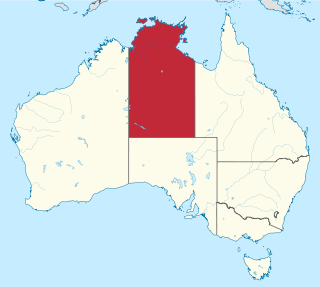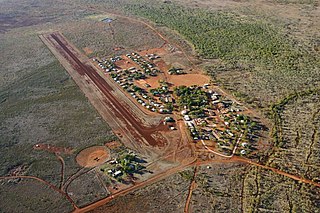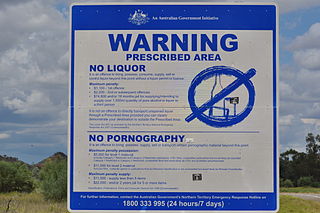Coronavirus pandemic
Binjari attracted international attention after an outbreak of COVID-19 occurred in the community in 2021. Following the detection of 9 positive cases in the small community on 20 November, [3] the Northern Territory Government imposed a hard lockdown, requesting assistance from the Australian Defence Force with relocation and quarantine of infected persons and close contacts due to the vulnerability of the Indigenous population. [4]
The measures implemented were some of the toughest in Australia, certainly more so than experienced by any town in the Northern Territory. Residents were not allowed to leave their homes for any reason other than for medical emergencies or where required by law. [5] NT Police established checkpoints on the road leading in and out of the community, with Defence Personnel providing additional capacity to check vehicles. [6]
As a result of this response, local authorities personally received critical messages from social media users as far away as the United States, claiming that the Army was forcibly removing and vaccinating Aboriginal people against their will. In some cases, the relocation of infected residents was compared to genocide and the Stolen Generations. [7] Circulation of such misinformation complicated co-ordination of supply deliveries as well as the public health response. [8] Despite these claims, a number of Indigenous bodies were supportive of the Territory Government's actions, including the Aboriginal Medical Services Alliance and Northern Land Council, who expressed confidence that the measures were appropriate to protect the vulnerable communities from the outbreak. [4] Representatives of the Defence Force stated their primary role was to assist with the delivery of food, supplies and providing transport for community members to attend medical appointments. [6]
On 3 December, an elder from the community became the first person to die of the disease in the Northern Territory. [9] The lockdown was lifted on 8 December [10] It was reported that of the estimated 300 people in the community at the start of the lockdown, close to 200 had been transported to the Howard Springs quarantine facility, 300 km (190 mi) away. [5]

The Northern Territory is a federal Australian territory in north-central Australia. It is the third largest Australian federal division with an area of 1,348,094.3 square kilometres (520,502 sq mi) but the least populous with 245,929 inhabitants as at June 2019. The Northern Territory is divided administratively into 17 Local government areas (LGAs) generally known as Councils who are responsible for providing local government services.
The Garma Festival of Traditional Cultures (Garma) is Australia's largest Indigenous cultural gathering, taking place over four days each August in northeast Arnhem Land, in the Northern Territory, Australia. Hosted by the Yothu Yindi Foundation, Garma is a celebration of the cultural traditions of the Yolngu people, and a major community gathering for the clans and families of the Arnhem Land region. The event showcases traditional miny'tji (art), ancient story-telling, manikay (song), and bunggul (dance). It is held at Gulkula, a significant Gumatj ceremonial site about 40 kilometres (25 mi) from the township of Nhulunbuy, attracts more than 2500 guests each year and is often sold out months in advance.

Lajamanu, formerly known as Hooker Creek Native Settlement or just Hooker Creek, is a small town of the Northern Territory of Australia. It is located around 560 km (350 mi) from Katherine and approximately 890 km (550 mi) from Darwin. At the 2016 Australian census, Lajamanu had a population of 606, of whom 89.3 percent are of Aboriginal and/or Torres Strait Islander origin, chiefly Warlpiri people.

The Northern Territory National Emergency Response, also known as "The Intervention" or the Northern Territory Intervention, and sometimes the abbreviation "NTER" was a package of measures enforced by legislation affecting Indigenous Australians in the Northern Territory (NT) of Australia, which lasted from 2007 until 2012. The measures included restrictions on the consumption of alcohol and pornography, changes to welfare payments, and changes to the delivery and management of education, employment and health services in the Territory.

Howard Springs is a locality in the Northern Territory. It is 29 kilometres (18 mi) SE of the Darwin CBD. Its local government area is the Litchfield Municipality. The suburb is mostly a rural area, but has been experiencing strong growth in population and development. From 2020, it has housed a major quarantine facility.

The Granites, also known as the Tanami Mine, is a gold mine in the Tanami Desert of the Northern Territory of Australia. It has been operated by Newmont Mining since 2002. The mine is about 540 km (340 mi) north-west of Alice Springs.
The COVID-19 pandemic in Australia was a part of the worldwide pandemic of the coronavirus disease 2019 caused by severe acute respiratory syndrome coronavirus 2. The first confirmed case in Australia was identified on 25 January 2020, in Victoria, when a man who had returned from Wuhan, Hubei Province, China, tested positive for the virus. As of 6 August 2022, Australia has reported over 11,350,000 cases, over 11,330,000 recoveries, and 19,265 deaths. Victoria's second wave having the highest fatality rate per case.

The COVID-19 pandemic in Fiji is part of the ongoing worldwide pandemic of coronavirus disease 2019 caused by severe acute respiratory syndrome coronavirus 2. The first case of the disease in Fiji was reported on 19 March 2020 in Lautoka. as of 3 January 2022, the country has had a total of 55,009 cases as of which 2,417 are currently active and 702 deaths, with cases reported on all divisions of the country. Apart from the COVID-19 deaths, 621 COVID-19 positive patients have died from pre-existing non-COVID-19 related illnesses. In March 2021, Fiji became the first Pacific island country to receive COVID-19 vaccines through the COVAX initiative with frontline workers and first responders the first to be vaccinated. As of 2 January 2022, more than 600,000 (98%) Fijians have received their first jab of the vaccine and almost 560,000 (92%) Fijians have received their second jab and are fully vaccinated. To date, only the AstraZeneca vaccine, Moderna vaccine and the Pfizer BioNTech vaccine have been deployed in the country. The country have also administered booster shots. Vaccination is mandated, however only to the adult population.
Bäniyala is a tiny community of Aboriginal Australian people, known as a homeland, situated on Blue Mud Bay in the Gulf of Carpentaria in East Arnhem Land in the Northern Territory of Australia, located 210 kilometres (130 mi) from Nhulunbuy. It is home to about 150 Yolŋu people.

This article documents the chronology of the response to the COVID-19 pandemic in May 2021, which originated in Wuhan, China in December 2019. Some developments may become known or fully understood only in retrospect. Reporting on this pandemic began in December 2019.
The COVID-19 pandemic in New South Wales, Australia was part of the worldwide pandemic of the coronavirus disease 2019 caused by severe acute respiratory syndrome coronavirus 2. The first confirmed case in New South Wales was identified on 19 January 2020 in Sydney where three travellers returning from Wuhan, Hubei, China, tested positive for the virus.
The COVID-19 pandemic in Victoria was part of the worldwide pandemic of the coronavirus disease 2019 caused by severe acute respiratory syndrome coronavirus 2. The first confirmed case in the state of Victoria, also the first in Australia, was identified as being on 19 January 2020, when a man from Wuhan arrived by air from Guandong, China. His test results on 25 January confirmed he had COVID-19.
The COVID-19 pandemic in Queensland, Australia is part of the ongoing worldwide pandemic of the coronavirus disease 2019 caused by severe acute respiratory syndrome coronavirus 2.

The COVID-19 pandemic in Western Australia is part of the ongoing worldwide pandemic caused by severe acute respiratory syndrome coronavirus 2. Western Australia (WA) confirmed its first case of COVID-19 on 21 February 2020, and its first death on 1 March. On 15 March, premier Mark McGowan declared a state of emergency. On 24 March, Western Australia closed its borders to the rest of Australia, and on 1 April, the state implemented borders between regions in the state. By mid-April 2020, the state had eliminated community transmission of COVID-19, becoming one of the few places in the world to do so. There were only a handful of cases of community transmission in the state after mid-April, until late December 2021 when a tourist caused an outbreak that led to the cancelling of some New Year's Eve events, and the re-imposing of mask wearing rules in Perth and the Peel region.
The COVID-19 pandemic in the Australian Capital Territory is part of the ongoing worldwide pandemic of the coronavirus disease 2019 caused by severe acute respiratory syndrome coronavirus 2. After one case of the delta variant in mid-August 2021, the Territory went into lockdown. By 26 September, the ACT had its first COVID-19 related death since mid-April 2020, nearly 18 months, followed by 3 more deaths in the first week of October 2021. 28 deaths during the outbreak since 12 August 2021 brought total deaths to 31, the most recent being on 8 February 2022.
The COVID-19 pandemic in the Northern Territory is part of the ongoing worldwide pandemic of the coronavirus disease 2019 caused by severe acute respiratory syndrome coronavirus 2.
The COVID-19 pandemic in Tasmania is part of the ongoing worldwide pandemic of the coronavirus disease 2019 caused by severe acute respiratory syndrome coronavirus 2.
This article documents the chronology and epidemiology of SARS-CoV-2, the virus which causes the coronavirus disease 2019 (COVID-19) and is responsible for the COVID-19 pandemic in Australia during 2020.
This article documents the chronology and epidemiology of SARS-CoV-2, the virus which causes the coronavirus disease 2019 (COVID-19) and is responsible for the COVID-19 pandemic in Australia during the first half of 2021.
This article documents the chronology and epidemiology of SARS-CoV-2, the virus which causes the coronavirus disease 2019 (COVID-19) and is responsible for the COVID-19 pandemic in Australia during the second half of 2021.







